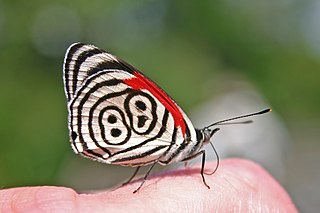In Greek mythology, Ceryx was a son of Hermes and either Pandrosus or Agraulus. He was, like his father, a messenger. But the kêryx career began as a humble cook for the tribe, a skill Hermes demonstrates in his cooked meat offerings on the Twelve Gods Altar set in place 522BC by Peisistratos III in Athens. The Homeric Hymn to Hermes 128 recalls the young god cutting out and laying up twelve steaks on a flat rock or platamoni," the 12 Gods altar.

Ceryx is a genus of moths in the family Erebidae. It was described by Hans Daniel Johan Wallengren in 1863.

Diaethria is a brush-footed butterfly genus found in the Neotropical realm, ranging from Mexico to Paraguay.
Similodonta is an extinct genus of early bivalve in the extinct family Praenuculidae. The genus is one of eleven genera in the subfamily Praenuculinae. Similodonta is known from Middle Ordovician through Middle Silurian fossils found in Europe and North America. The genus currently contains eight accepted species, Similodonta ceryx, Similodonta collina, Similodonta djupvikensis, Similodonta magna, Similodonta recurva, Similodonta spjeldnaesi, Similodonta wahli and the type species Similodonta similis.
Ceryx aethalodes is a moth of the subfamily Arctiinae. It was described by Wileman and West in 1928. It is found on the Philippines (Luzon).
Ceryx bernhardi is a moth of the subfamily Arctiinae. It was described by Seitz.
Ceryx burgeffi is a moth of the subfamily Arctiinae. It was described by Obraztsov in 1949. It is found on Java.
Ceryx calcuni is a moth of the subfamily Arctiinae. It was described by Obraztsov in 1957. It is found on Java.
Ceryx carpentieri is a moth of the subfamily Arctiinae. It was described by Abel Dufrane in 1936. It is found in the Democratic Republic of the Congo.
Ceryx evar is a moth of the subfamily Arctiinae. It was described by Pagenstecher in 1886. It is found on Ambon Island, Aru and the Key Islands.
Ceryx hageni is a moth of the subfamily Arctiinae. It was described by Snellen in 1895. It is found on Sumatra.
Ceryx helodiaphana is a moth of the subfamily Arctiinae. It was described by Roepke in 1937. It is found on Java.
Ceryx javanica is a moth of the subfamily Arctiinae. It was described by Obraztsov in 1949. It is found on Java.
Ceryx keiensis is a moth of the subfamily Arctiinae. It was described by Rothschild in 1910. It is found on the Key Islands.
Ceryx kuehni is a moth of the subfamily Arctiinae. It was described by Rothschild in 1910. It is found on Taam Island, west of Key Islands.
Ceryx lamottei is a moth of the subfamily Arctiinae. It was described by Kiriakoff in 1963. It was described from Nimba.
Ceryx macgregori is a moth of the subfamily Arctiinae. It was described by Schultze in 1900. It is found on the Philippines.
Ceryx salutator is a moth of the subfamily Arctiinae. It was described by Kiriakoff in 1965. It is found in the Democratic Republic of Congo.
Ceryx sambavana is a moth of the subfamily Arctiinae. It was described by George Hampson.
Ceryx sumatrensis is a moth of the subfamily Arctiinae. It was described by Obraztsov in 1949. It is found on Sumatra.



